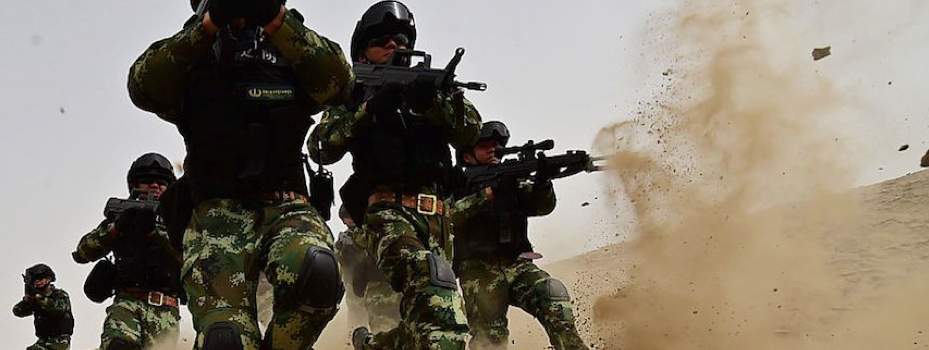Uighur militant groups are splitting, and may now compete to see who can hit China the hardest.
On Feb. 27, the Islamic State released a slickly produced propaganda video detailing for the first time “scenes from the life of immigrants from East Turkistan [i.e. Xinjiang] in the land of the Caliphate.” The video, in which a Uighur militant exclaims that the Islamic State will “shed blood like rivers” to avenge Beijing’s “oppression” of Muslims in the Western region of Xinjiang, provides not only a highly stylized view of Uighur militants’ training with heavy weaponry and snapshots of their daily life in the “caliphate,” but is also punctuated by two brutal executions of alleged “informants.”
While the direct threat against China and the brutality of the executions has captured much attention, a close analysis of the video suggests something even more important: the possible splintering of Uighur militancy.
The video demonstrates the intensification of the Islamic State’s threat to China. In 2014, Islamic State leader Abu Bakr al-Baghdadi argued that China was on a par with states such as Israel, India, and the United States as an “oppressor” of Muslims. This was followed by the group’s execution of a Chinese citizen, Fan Jinghui in Iraq in November 2015. The new video adds to this by providing the first visual evidence of Uighur militants fighting for the Islamic State and lends greater weight to Chinese claims that hundreds of Uighurs have been recruited by the group in recent years.
Revealingly, a militant in the video denounces the “apostasy” of the Turkistan Islamic Party (TIP) — a well-established Uighur militant group
 Revealingly, a militant in the video denounces the “apostasy” of the Turkistan Islamic Party (TIP) — a well-established Uighur militant group
Revealingly, a militant in the video denounces the “apostasy” of the Turkistan Islamic Party (TIP) — a well-established Uighur militant group
that has had a significant presence in Syria since 2012 — and urges TIP members to defect to the Islamic State. This leads to a significant implication: it highlights a potential splintering of Uighur militants between the well established Al Qaeda-affiliate, TIP, and the Islamic State.
To date, TIP has posed the most immediate terrorist threat to China. This has been based on its close alignment with Al Qaeda, a product of the group’s genesis in Taliban-controlled Afghanistan in the late 1990s. As Al Qaeda itself became active in Syria with the establishment of Jabhat al-Nusra as its affiliate in January 2012, TIP also began to release videos about the Syrian conflict and articles in its magazine, often comparing the struggle of the anti-Assad forces to that of the Uighurs in China. By 2015 TIP had a well-documented presence on the battlefield in Syria, with the group releasing a number of videos detailing its role in combat in Idlib, Jisr al-Shughur, and the Al Ghab plain. There have also been reports of the establishment of significant settlements of Uighur fighters and their families (numbered in their hundreds) since 2014 around Idlib and Latakia.
Throughout TIP has remained a steadfast ally of Al Qaeda and its affiliates in Syria, Jabhat al-Nusrah and its leadership has openly criticized the Islamic State and rejected the legitimacy of its “caliph,” Baghdadi. Al Qaeda for its part has widely praised TIP. Ayman al-Zawahiri, for instance, released a video in July 2016 titled “Turkestan: Patience and Then Victory,” that hailed TIP for its struggle against the “atheist occupier” of “East Turkestan” (i.e. Xinjiang) and encouraged followers to wage jihad “in any corner of the world, wherever they may be.” The video provides confirmation that the Al Qaeda-Islamic State split has now begun to affect Uighur militant groups.
Such splintering could, however, have contradictory effects. One could be broadly positive for China; inter-group conflict presaged by the video could distract and weaken Uighur militants’ ability to carry out attacks against China or its interests. Conversely, competition between TIP and Islamic State-aligned Uighurs in fact may present China with a metastasizing threat
 competition between TIP and Islamic State-aligned Uighurs in fact may present China with a metastasizing threat
competition between TIP and Islamic State-aligned Uighurs in fact may present China with a metastasizing threat
to Xinjiang and its interests in Central Asia and the Middle East.
The latter dynamic may already be taking place, discernible in the August 2016 attack against the Chinese embassy in Bishkek, Kyrgyzstan, and the 2016 New Year’s Eve Istanbul nightclub attack. In the first of these attacks, the suicide bomber was revealed to have been an ethnic Uighur who Kyrgyz authorities subsequently claimed had been travelling on a Tajik passport and assisted by an ethnic Uzbek with links to the TIP in Syria. The 2016 New Year’s Eve attack was claimed by the Islamic State, and Turkish authorities subsequently identified the gunman as an ethnic Uighur with links to Syria.
These developments present a major challenge to Beijing. Within Xinjiang, China has responded to the growing threat with a show of force, including recent “anti-terror” rallies of thousands of security personnel in major cities such as Urumqi, Kashgar, and Khotan. Externally, however, the question of how the activities of TIP and now Islamic State-aligned Uighur militants will affect Beijing’s approach to Iraq and Syria remain unclear. Ultimately, Beijing may have to jettison its long-standing aloofness to the crisis in both countries if China wishes to combat Uighur militancy effectively.
Source: foreignpolicy.com

Leave a Reply